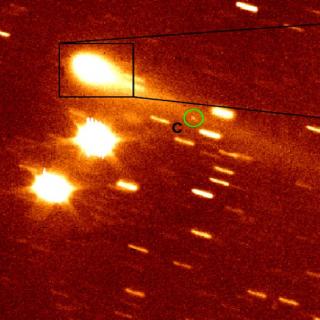Bibcode
Moreno, F.; Licandro, J.; Cabrera-Lavers, A.
Referencia bibliográfica
The Astrophysical Journal Letters, Volume 761, Issue 1, article id. L12, 6 pp. (2012).
Fecha de publicación:
12
2012
Número de citas
27
Número de citas referidas
27
Descripción
We present observations and an interpretative model of the dust
environment of the Main-Belt Comet P/2010 F5 (Gibbs). The narrow dust
trails observed can be interpreted unequivocally as an impulsive event
that took place around 2011 July 1 with an uncertainty of ±10
days, and a duration of less than a day, possibly of the order of a few
hours. The best Monte Carlo dust model fits to the observed trail
brightness imply ejection velocities in the range 8-10 cm
s–1 for particle sizes between 30 cm and 130 μm.
This weak dependence of velocity on size contrasts with that expected
from ice sublimation and agrees with that found recently for (596)
Scheila, a likely impacted asteroid. The particles seen in the trail are
found to follow a power-law size distribution of index ≈–3.7.
Assuming that the slowest particles were ejected at the escape velocity
of the nucleus, its size is constrained to about 200-300 m in diameter.
The total ejected dust mass is >~ 5 × 108 kg, which
represents approximately 4%-20% of the nucleus mass.
Proyectos relacionados

Pequeños Cuerpos del Sistema Solar
Este Proyecto estudia las propiedades físicas y composicionales de los llamados pequeños cuerpos del Sistema Solar, que incluyen asteroides, objetos helados y cometas. Entre los grupos de mayor interés destacan los objetos trans-neptunianos (TNOs), incluyendo los objetos más lejanos detectados hasta la fecha (Extreme-TNOs o ETNOs); los cometas, y
Julia de
León Cruz